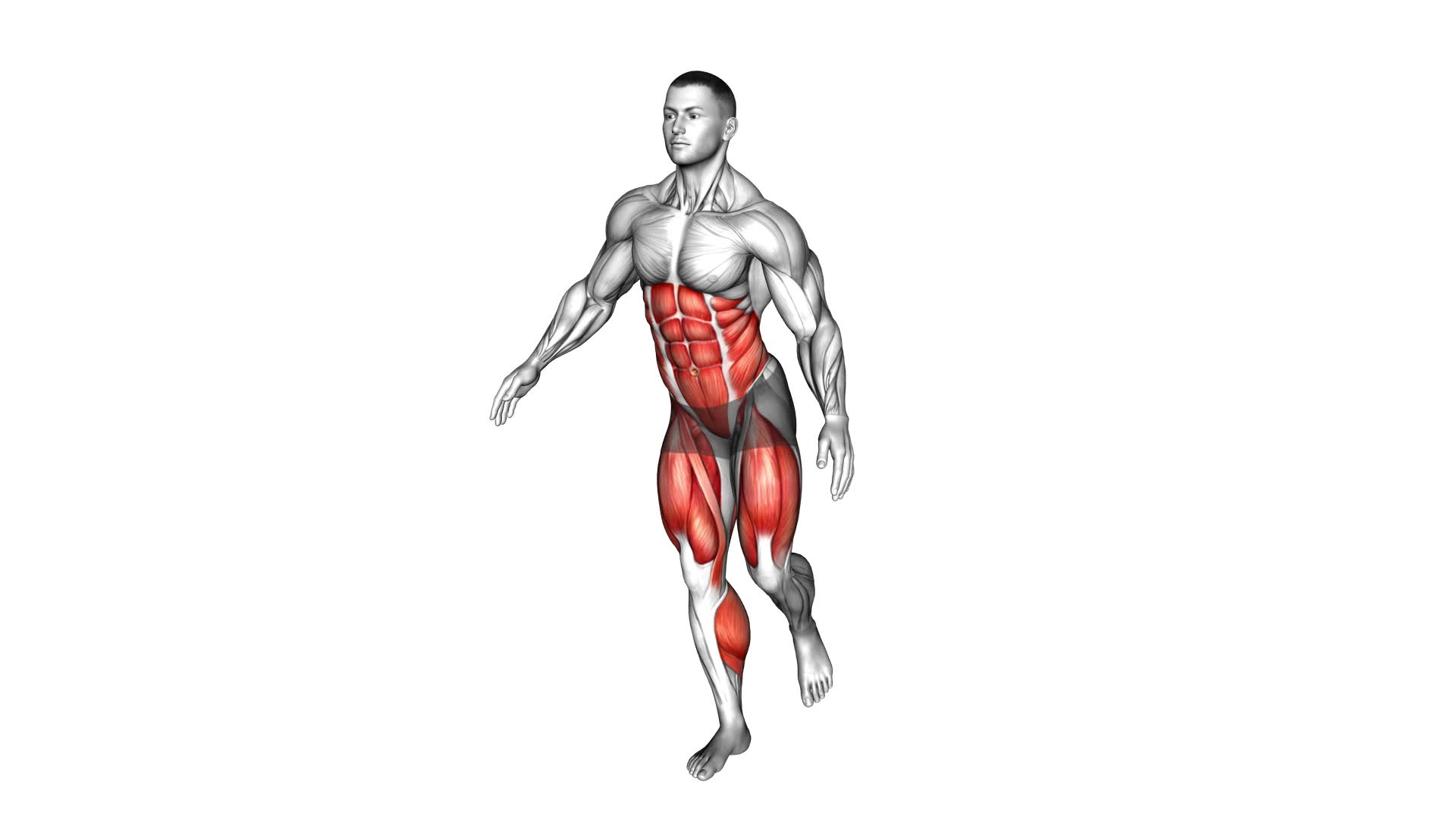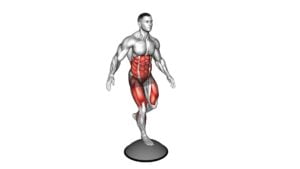Single Leg Stand – Video Exercise Guide & Tips

Are you looking for an effective exercise to improve your balance and strengthen your legs? Look no further than the Single Leg Stand!
Watch This Exercise Video
This video exercise guide and tips will show you the proper technique, common mistakes to avoid, and modifications to challenge yourself.
Incorporating the Single Leg Stand into your routine is a great way to enhance your overall fitness.
Get ready to feel stronger and more stable with this simple yet powerful exercise.
Key Takeaways
- The single leg stand improves balance and strengthens leg muscles.
- Proper technique includes standing tall with feet hip-width apart, engaging core muscles, and shifting weight onto one leg with a slight knee bend.
- Common mistakes to avoid include not maintaining proper form, leaning too far forward or backward, and rushing through the exercise.
- Modifications and progressions for the single leg stand include elevated versions, adding arm movements, closing eyes, and gradually increasing difficulty and duration.
Benefits of the Single Leg Stand
Improve your balance and strengthen your leg muscles with the Single Leg Stand exercise. This exercise is a simple yet effective way to target these areas and enhance your overall stability.
By focusing on one leg at a time, you engage the muscles in your standing leg to maintain balance, while also working the muscles in your supporting leg for strength.
The Single Leg Stand exercise is particularly beneficial for improving balance. As you balance on one leg, your body is forced to engage the muscles in your core, hips, and ankles to maintain stability. Over time, this can help to improve your overall balance and prevent falls or injuries.
In addition to balance improvements, the Single Leg Stand exercise also strengthens your leg muscles. When you stand on one leg, you activate the muscles in your glutes, quadriceps, and hamstrings to support your body weight. Regularly performing this exercise can lead to increased strength and stability in your legs.
To get the most out of the Single Leg Stand exercise, start by standing tall with your feet hip-width apart. Lift one foot off the ground and balance on the other leg. Aim to hold this position for 30 seconds to a minute, then switch legs. As you progress, you can challenge yourself by closing your eyes or adding a small balance prop.
Incorporating the Single Leg Stand exercise into your fitness routine can help improve your balance and strengthen your leg muscles. Give it a try and experience the benefits for yourself.
Proper Technique for the Single Leg Stand
To perform the Single Leg Stand exercise with proper technique, you need to maintain a strong and stable position while balancing on one leg. This exercise is highly effective for improving balance and strengthening leg muscles. Here are three key tips to ensure you perform the Single Leg Stand correctly:
- Start by standing tall with your feet hip-width apart. Engage your core muscles by drawing your belly button in towards your spine.
- Shift your weight onto one leg while keeping a slight bend in the knee. Avoid locking your knee as this can lead to injury.
- Extend your other leg forward, keeping it parallel to the ground. Keep your foot flexed and toes pointing forward. If you have difficulty balancing, you can place your foot lightly on the ground for support.
As you hold this position, focus on maintaining a steady breath and a relaxed upper body. Aim to hold the Single Leg Stand for 30 seconds on each leg, gradually increasing the duration as you build strength and stability.
Remember to switch sides to work both legs equally. By practicing proper technique, you'll maximize the benefits of this exercise and improve your balance while strengthening your leg muscles.
Common Mistakes to Avoid
Avoid these common mistakes when performing the Single Leg Stand exercise to ensure proper technique and maximize its benefits.
One common mistake to avoid isn't maintaining proper form. It's important to keep your standing leg slightly bent and your hips level throughout the exercise. This will help to stabilize your body and prevent any unnecessary strain on your joints.
Another mistake to avoid is leaning too far forward or backward. This can throw off your balance and make it difficult to maintain the single leg position. Instead, focus on keeping your torso upright and your weight evenly distributed over your standing foot.
Lastly, avoid rushing through the exercise. Take your time and focus on maintaining stability and control throughout each repetition.
Modifications and Progressions for the Single Leg Stand
To further challenge yourself and improve your balance, consider incorporating modifications and progressions into your Single Leg Stand exercise routine. These variations will help you build single leg balance and enhance your stability training.
Here are three modifications and progressions you can try:
- Elevated Single Leg Stand: Place the foot of your non-standing leg on a step or an elevated surface. This will increase the difficulty by requiring more stability and strength from your standing leg.
- Single Leg Stand with Arm Movements: While balancing on one leg, extend your arms out to the sides or overhead. This adds an extra challenge by engaging your core muscles and improving overall body control.
- Single Leg Stand with Eye Closed: Close your eyes while performing the Single Leg Stand exercise. This removes visual cues and forces your body to rely more on proprioception, which is your body's sense of position and movement. This modification greatly enhances your balance and stability training.
Incorporating these modifications and progressions into your Single Leg Stand routine will help you progress and continually challenge yourself. Remember to start with the basic version and gradually increase the difficulty as you become more comfortable and confident in your single leg balance.
Tips for Incorporating the Single Leg Stand Into Your Exercise Routine
To effectively incorporate the Single Leg Stand into your exercise routine, focus on maintaining proper form and gradually increasing the duration of the exercise. This won't only help in injury prevention but also improve your balance and stability.
First and foremost, it's crucial to start with the correct form. Stand tall with your feet hip-width apart and engage your core muscles. Shift your weight onto one leg while keeping a slight bend in the knee. Lift the other leg off the ground, keeping it straight and parallel to the floor. Maintain a neutral spine and gaze forward to help with balance.
As you begin practicing the Single Leg Stand, start with shorter durations and gradually increase the time as your strength and balance improve. Aim for 10-20 seconds initially and work your way up to 30-60 seconds per leg. It's important to listen to your body and not push yourself too hard, as this can lead to injury.
To challenge your balance and stability further, you can try closing your eyes during the exercise. This will force your body to rely solely on proprioception, the sense of the position and movement of your body. However, be cautious and only attempt this once you feel comfortable and confident with the exercise.
Incorporating the Single Leg Stand into your exercise routine won't only help prevent injuries but also improve your balance and stability. Remember to maintain proper form, gradually increase the duration, and listen to your body. With consistency and patience, you'll see improvements in your overall body control and stability.
Frequently Asked Questions
What Are Some Potential Modifications for Individuals With Limited Balance or Stability?
If you have limited balance or stability, there are a few modifications you can try for the single leg stand exercise.
First, you can hold onto a chair or wall for support. This will help you maintain your balance while still working on strengthening your leg muscles.
Another option is to perform the exercise while seated on a stable surface, such as a bench or chair. This will reduce the demand on your balance and allow you to focus on building strength.
Can the Single Leg Stand Exercise Help Improve Ankle Strength and Stability?
The single leg stand exercise is a great way to improve ankle strength and stability. By focusing on balancing on one leg, you're challenging the muscles in your ankle and foot, which can help improve their strength and stability over time.
This exercise is especially beneficial for individuals looking to improve ankle mobility and overall balance. Incorporating single leg balance exercises into your routine can have numerous benefits for your lower body strength and stability.
Are There Any Variations of the Single Leg Stand That Can Target Specific Muscle Groups?
Variations of the single leg stand can indeed target specific muscle groups. By adding resistance bands around your ankles, you can engage your hip abductors and glutes more intensively.
If you want to focus on your quadriceps, try using a stability ball against a wall while performing the exercise. Alternatively, holding a dumbbell in one hand can challenge your core and upper body stability.
These variations provide a great way to target different muscle groups during the single leg stand exercise.
Is It Normal to Experience Some Muscle Fatigue or Discomfort During the Single Leg Stand Exercise?
It is normal to experience some muscle fatigue or discomfort during the single leg stand exercise. This is because it requires a lot of balance and stability, as well as strength in the ankle.
If you have limited balance, there are modifications you can try, such as using a wall or chair for support.
The single leg stand is a great exercise for improving ankle strength and stability, and it can also benefit athletes by improving their sports performance.
Can the Single Leg Stand Exercise Be Beneficial for Athletes Looking to Improve Their Sports Performance?
The single leg stand exercise can be highly beneficial for athletes aiming to improve their sports performance. It has a significant impact on agility and quickness, allowing athletes to move swiftly and change direction efficiently.
Additionally, this exercise helps in preventing injuries by strengthening the muscles and improving balance. Incorporating the single leg stand into your training routine can greatly enhance your athletic abilities and keep you at the top of your game.
Conclusion
Incorporating the single leg stand into your exercise routine offers numerous benefits, such as improving balance, stability, and leg strength.
By following proper technique and avoiding common mistakes, you can maximize the effectiveness of this exercise.
Additionally, modifications and progressions allow you to tailor the single leg stand to your fitness level.
So why not give it a try and reap the rewards of this simple yet effective exercise?

Author
Years ago, the spark of my life’s passion ignited in my mind the moment I stepped into the local gym for the first time. The inaugural bead of perspiration, the initial endeavor, the very first surge of endorphins, and a sense of pride that washed over me post-workout marked the beginning of my deep-seated interest in strength sports, fitness, and sports nutrition. This very curiosity blossomed rapidly into a profound fascination, propelling me to earn a Master’s degree in Physical Education from the Academy of Physical Education in Krakow, followed by a Sports Manager diploma from the Jagiellonian University. My journey of growth led me to gain more specialized qualifications, such as being a certified personal trainer with a focus on sports dietetics, a lifeguard, and an instructor for wellness and corrective gymnastics. Theoretical knowledge paired seamlessly with practical experience, reinforcing my belief that the transformation of individuals under my guidance was also a reflection of my personal growth. This belief holds true even today. Each day, I strive to push the boundaries and explore new realms. These realms gently elevate me to greater heights. The unique combination of passion for my field and the continuous quest for growth fuels my drive to break new ground.



